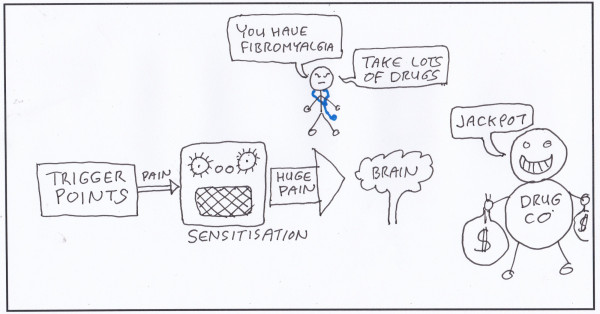
Summary
Fibromyalgia is understood to be a malfunction of the nervous system that causes pain to be increased plus a host of other symptoms. Therefore, when we look at the cause of fibromyalgia we need to look at two levels:
- What is the malfunction of the nervous system that causes the symptoms, and
- what causes that malfunction?
The cause of the symptoms
Although the cause of fibromyalgia is said to be unknown, scientists understand in general terms that the symptoms are caused by a sensitisation of the nervous system causing it to act like an amplifier. Because of this normal stimuli becomes painful and pain becomes much worse. Also, because the nervous system control practically everything in your body it can cause a host of seemingly unrelated symptoms.
The cause of the malfunction (Sensitisation)
The cause in general
Your nervous system is extremely complex and processes a wide range of information, so it’s function can be affected (sensitised) by a wide range of things ranging from diseases and chemical imbalances through to emotional stress.
Specific causes
Issues such as emotional stress and traumatic events are known to be important causes. However, scientists have found that the biggest cause is prolonged pain from another source. Arthritic joints and even tennis elbow have been identified. However, scientists have found that by far the most common source of this pain is un-diagnosed or inadequately treated (Myofascial) Trigger Points , which are those tender lumps in your muscles that therapists find.
Duration and summation
Generally with any form of sensitisation the duration of exposure is important and the effects of exposures can add together. It is not uncommon for a person to be exposed to one form of stress for a long time, then some sort of incident or trauma acts as the proverbial straw that broke the camel's back.
Causes or symptoms?
While issues such as trigger points, arthritic joints and prolonged emotional stress appear to be genuine causes of sensitisation we have a range of things that could be causes or symptoms. For example say you have a food intolerance and modifying your diet helps with fibromyalgia symptoms. Is the food intolerance stressing your nervous system causing it to become sensitised, or has the issues with your nervous system affected your digestive function? We have no way of really telling.
Treating the cause of fibromyalgia
Treating the cause of the symptoms
In general, medics believe that the cause of fibromyalgia is sensitisation of the nervous system. Because of this they have lots of chemicals that slow down or suppress your nervous system. However, your nervous system performs a great many useful functions and these get suppressed too.
Treating the cause of the malfunction (sensitisation)
The good news is scientist have found that if you remove the cause of the sensitisation your nervous system will tend to re-program itself and go back to normal. They have actually done this in a clinical trial where trigger points were injected with anaesthetic to (temporarily) stop them bombarding the nervous system with pain. This considerably relieved the fibromyalgia symptoms. We will discuss this in detail in the next section.





